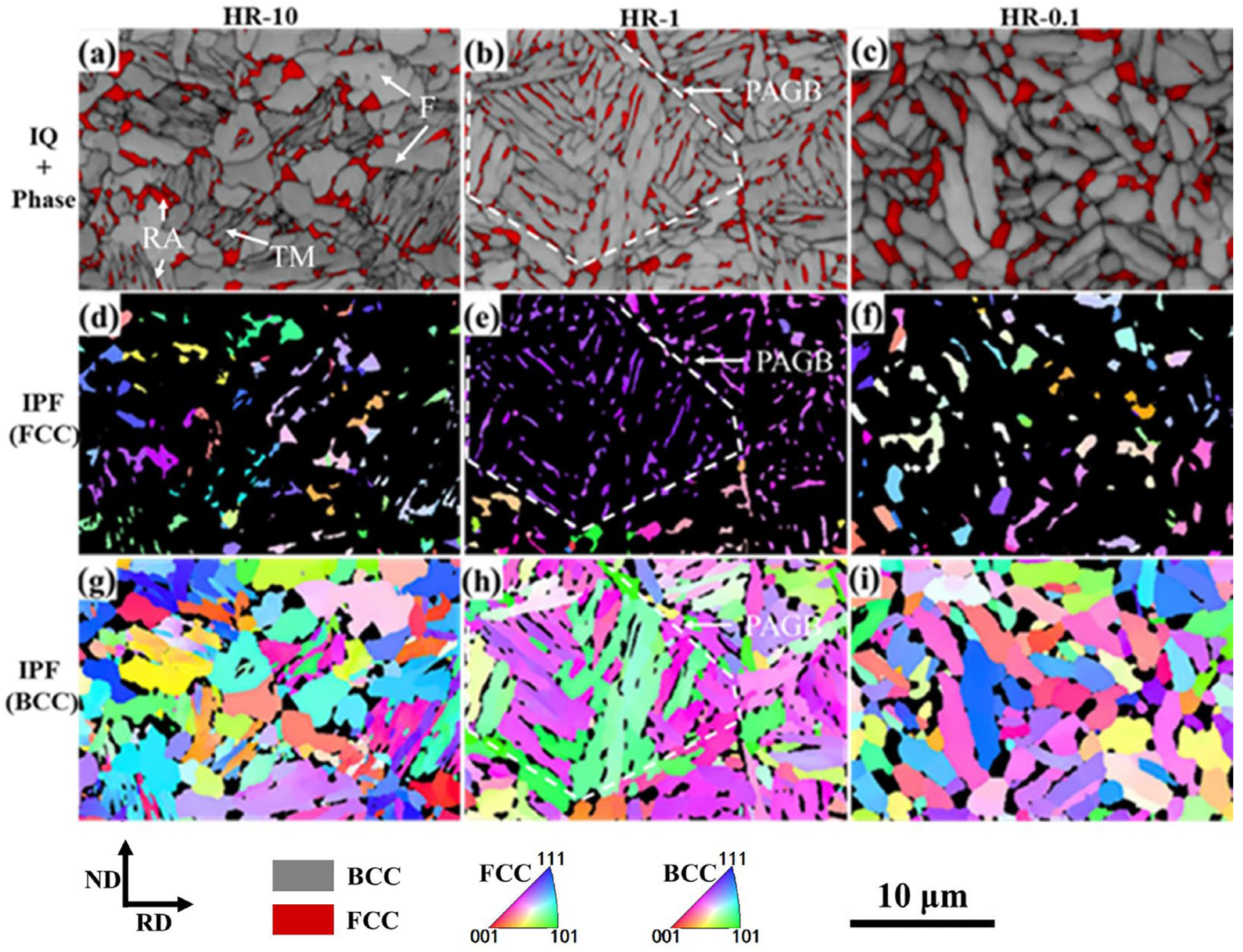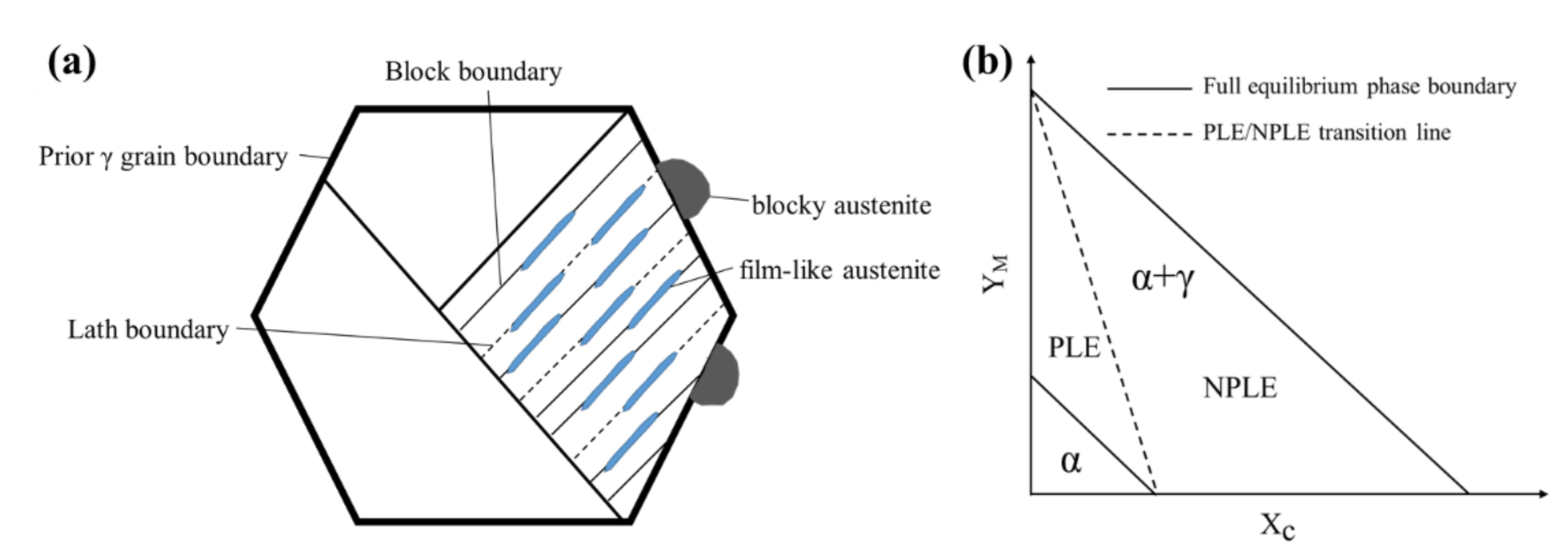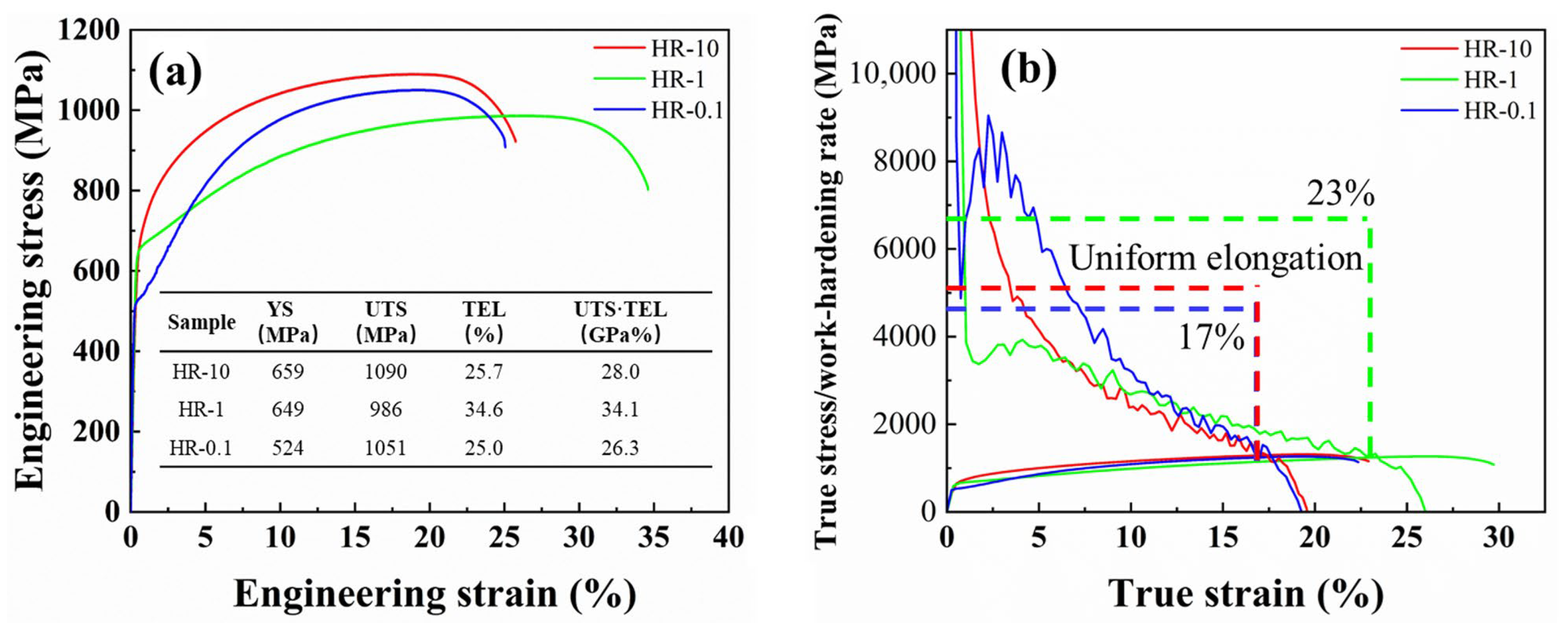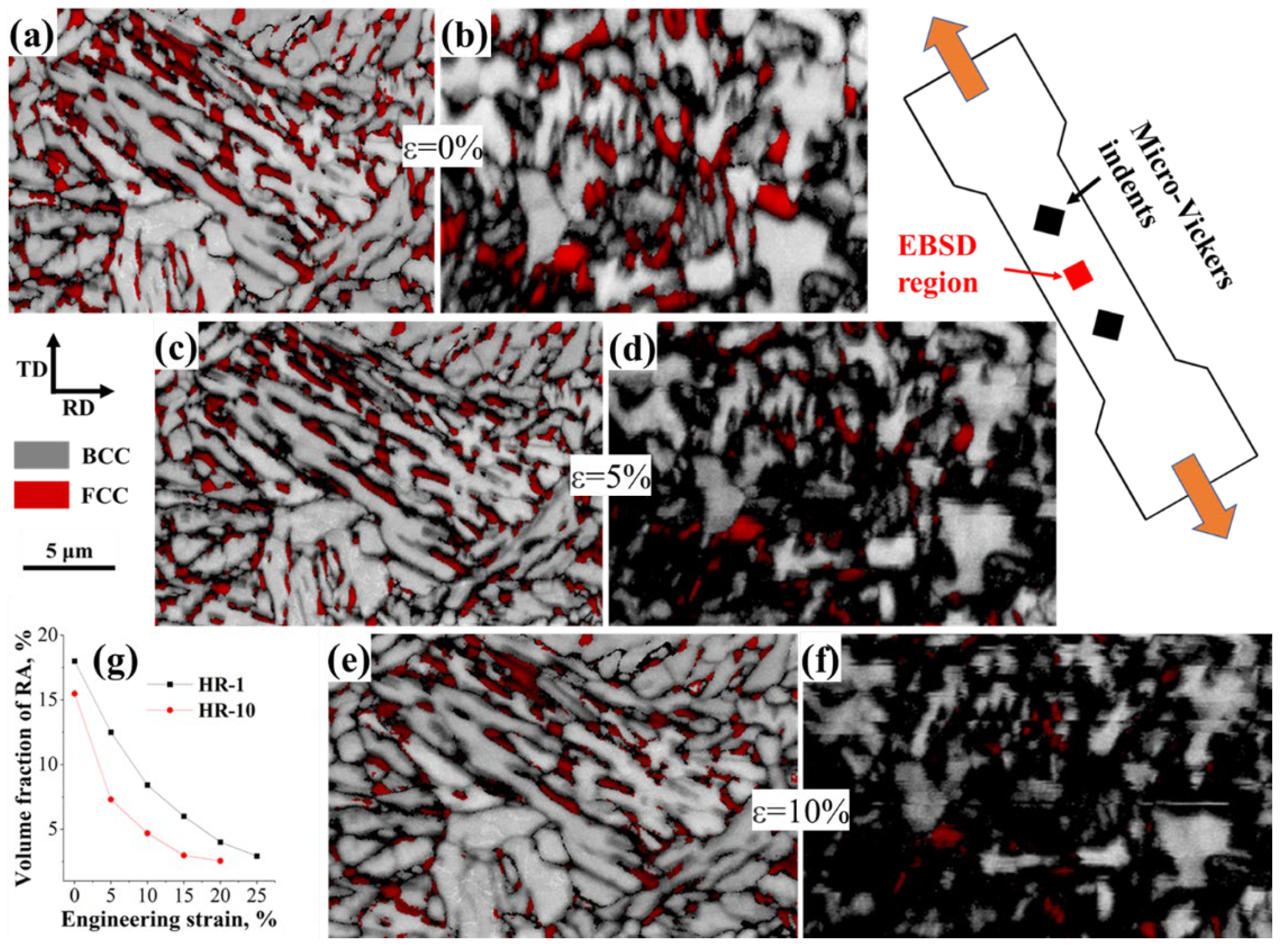Enhancing Mechanical Properties of Q&P Steel Through Tailoring Film-like Retained Austenite Morphology via Heating Rate Optimization
Abstract
1. Introduction
2. Materials and Methods
3. Results and Discussions
4. Conclusions
Author Contributions
Funding
Data Availability Statement
Conflicts of Interest
References
- Liu, L.; He, B.B.; Cheng, G.J.; Yen, H.W.; Huang, M.X. Optimum properties of quenching and partitioning steels achieved by balancing fraction and stability of retained austenite. Scr. Mater. 2018, 150, 1–6. [Google Scholar] [CrossRef]
- Sun, W.W.; Wu, Y.X.; Yang, S.C.; Hutchinson, C.R. Advanced high strength steel (AHSS) development through chemical patterning of austenite. Scr. Mater. 2018, 146, 60–63. [Google Scholar] [CrossRef]
- Xiong, X.C.; Chen, B.; Huang, M.X.; Wang, J.F.; Wang, L. The effect of morphology on the stability of retained austenite in a quenched and partitioned steel. Scr. Mater. 2013, 68, 321–324. [Google Scholar] [CrossRef]
- Speer, J.; Matlock, D.K.; De Cooman, B.C.; Schroth, J.G. Carbon partitioning into austenite after martensite transformation. Acta Mater. 2003, 51, 2611–2622. [Google Scholar] [CrossRef]
- Edmonds, D.V.; He, K.; Rizzo, F.C.; De Cooman, B.C.; Matlock, D.K.; Speer, J.G. Quenching and partitioning martensite—A novel steel heat treatment. Mater. Sci. Eng. A-Struct. 2006, 438, 25–34. [Google Scholar] [CrossRef]
- Clarke, A.J.; Speer, J.G.; Miller, M.K.; Hackenberg, R.E.; Edmonds, D.V.; Matlock, D.K.; Rizzo, F.C.; Clarke, K.D.; De Moor, E. Carbon partitioning to austenite from martensite or bainite during the quench and partition (Q&P) process: A critical assessment. Acta Mater. 2008, 56, 16–22. [Google Scholar] [CrossRef]
- Santofimia, M.J.; Petrov, R.H.; Zhao, L.; Sietsma, J. Microstructural analysis of martensite constituents in quenching and partitioning steels. Mater. Charact. 2014, 92, 91–95. [Google Scholar] [CrossRef]
- Xie, Z.-J.; Shang, C.-J.; Wang, X.-L.; Wang, X.-M.; Han, G.; Misra, R.-D.-K. Recent progress in third-generation low alloy steels developed under M 3 microstructure control. Int. J. Miner. Metall. Mater. 2020, 27, 1–9. [Google Scholar]
- Pierce, D.T.; Coughlin, D.R.; Clarke, K.D.; De Moor, E.; Poplawsky, J.; Williamson, D.L.; Mazumder, B.; Speer, J.G.; Hood, A.; Clarke, A.J. Microstructural evolution during quenching and partitioning of 0.2C-1.5Mn-1.3Si steels with Cr or Ni additions. Acta Mater. 2018, 151, 454–469. [Google Scholar] [CrossRef]
- Santofimia, M.J.; Zhao, L.; Petrov, R.; Kwakernaak, C.; Sloof, W.G.; Sietsma, J. Microstructural development during the quenching and partitioning process in a newly designed low-carbon steel. Acta Mater. 2011, 59, 6059–6068. [Google Scholar] [CrossRef]
- Hu, C.; Huang, C.P.; Liu, Y.X.; Perlade, A.; Zhu, K.Y.; Huang, M.X. The dual role of TRIP effect on ductility and toughness of a medium Mn steel. Acta Mater. 2023, 245, 118629. [Google Scholar] [CrossRef]
- Hu, X.H.; Sun, X.; Hector, L.G., Jr.; Ren, Y. Individual phase constitutive properties of a TRIP-assisted QP980 steel from a combined synchrotron X-ray diffraction and crystal plasticity approach. Acta Mater. 2017, 132, 230–244. [Google Scholar] [CrossRef]
- Tan, X.; Ponge, D.; Lu, W.; Xu, Y.; He, H.; Yan, J.; Wu, D.; Raabe, D. Joint investigation of strain partitioning and chemical partitioning in ferrite-containing TRIP-assisted steels. Acta Mater. 2020, 186, 374–388. [Google Scholar] [CrossRef]
- Mukherjee, M.; Mohanty, O.N.; Hashimoto, S.-I.; Hojo, T.; Sugimoto, K.-I. Strain-induced transformation behaviour of retained austenite and tensile properties of TRIP-aided steels with different matrix microstructure. ISIJ Int. 2006, 46, 316–324. [Google Scholar] [CrossRef]
- Wang, C.; Ding, H.; Cai, M.; Rolfe, B. Characterization of microstructures and tensile properties of TRIP-aided steels with different matrix microstructure. Mater. Sci. Eng. A 2014, 610, 65–75. [Google Scholar] [CrossRef]
- Ding, R.; Tang, D.; Zhao, A.M.; Dong, R.; Cheng, J.Y.; Zhang, X.Y. A New Type of Quenching and Partitioning Processing Developed from Martensitic Pre-microstructure. Mater. Manuf. Process 2014, 29, 704–709. [Google Scholar] [CrossRef]
- Santofimia, M.J.; Nguyen-Minh, T.; Zhao, L.; Petrov, R.; Sabirov, I.; Sietsma, J. New low carbon Q&P steels containing film-like intercritical ferrite. Mater. Sci. Eng. A 2010, 527, 6429–6439. [Google Scholar]
- Speer, J.G.; Edmonds, D.V.; Rizzo, F.C.; Matlock, D.K. Partitioning of carbon from supersaturated plates of ferrite, with application to steel processing and fundamentals of the bainite transformation. Curr. Opin. Solid State Mater. Sci. 2004, 8, 219–237. [Google Scholar] [CrossRef]
- Saito, R.; Nakada, N.; Yabu, S.; Hayashi, K. Effects of initial structure and reversion temperature on austenite nucleation site in pearlite and ferrite–pearlite. Metall. Mater. Trans. A 2018, 49, 6001–6009. [Google Scholar]
- Wang, S.; Chen, M.; Yang, M.; Huang, Y.; Wang, S.; Mao, X. Effect of Cold Rolling Reduction Rate on the Microstructure and Properties of Q&P Steel with a Ferrite-Pearlite Initial Structure. Materials 2023, 16, 6102. [Google Scholar]
- Wang, X.; Xu, Y.; Wang, Y.; Li, J.; Wang, Y.; Gu, X.; Misra, R.D.K. Combined effect of Cu partitioning and nano-size precipitates on improving strength-ductility balance of Cu bearing Q&P steel. Mater. Charact. 2022, 194, 112441. [Google Scholar] [CrossRef]
- Wu, R.M.; Li, W.; Wang, C.L.; Xiao, Y.; Wang, L.; Jin, X.J. Stability of Retained Austenite Through a Combined Intercritical Annealing and Quenching and Partitioning (IAQP) Treatment. Acta Metall. Sin-Engl. 2015, 28, 386–393. [Google Scholar] [CrossRef]
- Van Bohemen, S.; Morsdorf, L. Predicting the Ms temperature of steels with a thermodynamic based model including the effect of the prior austenite grain size. Acta Mater. 2017, 125, 401–415. [Google Scholar] [CrossRef]
- Zhang, C.; Xiong, Z.; Yang, D.; Cheng, X. Heterogeneous quenching and partitioning from manganese-partitioned pearlite: Retained austenite modification and formability improvement. Acta Mater. 2022, 235, 118060. [Google Scholar] [CrossRef]
- Sugimoto, K.; Kanda, A.; Kikuchi, R.; Hashimoto, S.; Kashima, T.; Ikeda, S. Ductility and formability of newly developed high strength low alloy TRIP-aided sheet steels with annealed martensite matrix. ISIJ Int. 2002, 42, 910–915. [Google Scholar] [CrossRef]
- Sugimoto, K.-i.; Yu, B.; Mukai, Y.-i.; Ikeda, S. Microstructure and formability of aluminum bearing TRIP-aided steels with annealed martensite matrix. ISIJ Int. 2005, 45, 1194–1200. [Google Scholar] [CrossRef]
- Ding, R.; Tang, D.; Zhao, A.M.; Dong, R.; Cheng, J.Y.; Meng, X. Effect of intercritical temperature on quenching and partitioning steels originated from martensitic pre-microstructure. J. Mater. Res. 2014, 29, 2525–2533. [Google Scholar] [CrossRef]
- Gao, P.F.; Chen, W.J.; Li, F.; Ning, B.J.; Zhao, Z.Z. Quasi-Situ Characterization of Deformation in Low-Carbon Steel with Equiaxed and Lamellar Microstructure Treated by the Quenching and Partitioning Process. Acta Metall. Sin-Engl. 2020, 33, 1657–1665. [Google Scholar] [CrossRef]
- Zhang, J.; Ding, H.; Misra, R.D.K.; Wang, C. Enhanced stability of retained austenite and consequent work hardening rate through pre-quenching prior to quenching and partitioning in a Q-P microalloyed steel. Mater. Sci. Eng. A-Struct. 2014, 611, 252–256. [Google Scholar] [CrossRef]
- Ding, R.; Tang, D.; Zhao, A. A novel design to enhance the amount of retained austenite and mechanical properties in low-alloyed steel. Scr. Mater. 2014, 88, 21–24. [Google Scholar] [CrossRef]
- Lu, J.; Yu, H.; Duan, X.; Song, C. Investigation of microstructural evolution and bainite transformation kinetics of multi-phase steel. Mater. Sci. Eng. A-Struct. 2020, 774, 138868. [Google Scholar] [CrossRef]
- Hajy Akbary, F.; Santofimia, M.J.; Sietsma, J. Influence of the Partitioning Treatment on the Mechanical Properties of a 0.3C-1.5Si-3.5Mn Q&P Steel. Adv. Mater. Res. 2014, 922, 224–229. [Google Scholar] [CrossRef]
- Salehiyan, D.; Samei, J.; Amirkhiz, B.S.; Hector, L.G., Jr.; Wilkinson, D.S. Microstructural Evolution During Deformation of a QP980 Steel. Metall. Mater. Trans. A 2020, 51, 4524–4539. [Google Scholar] [CrossRef]
- Santofimia, M.J.; Zhao, L.; Sietsma, J. Microstructural Evolution of a Low-Carbon Steel during Application of Quenching and Partitioning Heat Treatments after Partial Austenitization. Metall. Mater. Trans. A 2009, 40a, 46–57. [Google Scholar] [CrossRef]
- Zhao, H.S.; Zhu, X.; Li, W.; Jin, X.J.; Wang, L.; Jiao, H.; Jiang, D.M. Austenite stability for quenching and partitioning treated steel revealed by colour tint-etching method. Mater. Sci. Technol. 2014, 30, 1008–1013. [Google Scholar] [CrossRef]
- Zhao, H.S.; Li, W.; Zhu, X.; Lu, X.H.; Wang, L.; Zhou, S.; Jin, X.J. Quantitative assessment of retained austenite in quenching and partitioning treated multiphase steel. Mater. Sci. Technol. 2016, 32, 1619–1624. [Google Scholar] [CrossRef]
- Gao, P.F.; Liu, J.; Chen, W.J.; Li, F.; Pang, J.Y.; Zhao, Z.Z. Quasi-Situ Characterization of Retained Austenite Orientation in Quenching and Partitioning Steel via Uniaxial Tensile Tests. Materials 2020, 13, 4609. [Google Scholar] [CrossRef]
- Liu, Z.-Q.; Miyamoto, G.; Yang, Z.-G.; Zhang, C.; Furuhara, T. Effects of pre-tempering on intercritical annealing in Fe-2Mn-0.3 C Alloy. Metall. Mater. Trans. A 2014, 45, 5290–5294. [Google Scholar] [CrossRef]
- Plichta, M.; Aaronson, H. Influence of alloying elements upon the morphology of austenite formed from martensite in Fe-CX alloys. Metall. Mater. Trans. B 1974, 5, 2611–2613. [Google Scholar] [CrossRef]
- Zhang, C.; Yang, Z.; Enomoto, M.; Chen, H.; Yang, Z.; Zhang, C. Prediction of Ar3 during very slow cooling in low alloy steels. ISIJ Int. 2016, 56, 678–684. [Google Scholar] [CrossRef][Green Version]
- Wei, R.; Enomoto, M.; Radian, R.; Zurob, H.S.; Purdy, G.R. Growth of austenite from as-quenched martensite during intercritical annealing in an Fe-0.1C-3Mn-1.5Si alloy. Acta Mater. 2013, 61, 697–707. [Google Scholar] [CrossRef]
- Zhang, X.; Miyamoto, G.; Kaneshita, T.; Yoshida, Y.; Toji, Y.; Furuhara, T. Growth mode of austenite during reversion from martensite in Fe-2Mn-1.5Si-0.3C alloy: A transition in kinetics and morphology. Acta Mater. 2018, 154, 1–13. [Google Scholar] [CrossRef]
- Zhang, X.; Miyamoto, G.; Toji, Y.; Nambu, S.; Koseki, T.; Furuhara, T. Orientation of austenite reverted from martensite in Fe-2Mn-1.5Si-0.3C alloy. Acta Mater. 2018, 144, 601–612. [Google Scholar] [CrossRef]
- Zhang, X.; Miyamoto, G.; Toji, Y.; Zhang, Y.; Furuhara, T. Role of cementite and retained austenite on austenite reversion from martensite and bainite in Fe-2Mn-1.5Si-0.3C alloy. Acta Mater. 2021, 209, 116772. [Google Scholar] [CrossRef]
- Ovid’ko, I.A.; Valiev, R.Z.; Zhu, Y.T. Review on superior strength and enhanced ductility of metallic nanomaterials. Prog. Mater. Sci. 2018, 94, 462–540. [Google Scholar] [CrossRef]
- Masumura, T.; Nakada, N.; Tsuchiyama, T.; Takaki, S.; Koyano, T.; Adachi, K. The difference in thermal and mechanical stabilities of austenite between carbon- and nitrogen-added metastable austenitic stainless steels. Acta Mater. 2015, 84, 330–338. [Google Scholar] [CrossRef]
- Gao, F.; Gao, Z.; Zhu, Q.; Yu, F.; Liu, Z. Deformation behavior of retained austenite and its effect on plasticity based on in-situ EBSD analysis for transformable ferritic stainless steel. J. Mater. Res. Technol. 2022, 20, 1976–1992. [Google Scholar] [CrossRef]





Disclaimer/Publisher’s Note: The statements, opinions and data contained in all publications are solely those of the individual author(s) and contributor(s) and not of MDPI and/or the editor(s). MDPI and/or the editor(s) disclaim responsibility for any injury to people or property resulting from any ideas, methods, instructions or products referred to in the content. |
© 2025 by the authors. Licensee MDPI, Basel, Switzerland. This article is an open access article distributed under the terms and conditions of the Creative Commons Attribution (CC BY) license (https://creativecommons.org/licenses/by/4.0/).
Share and Cite
Wang, S.; Yang, M.; Chen, M.; Huang, Y.; Wang, S.; Mao, X. Enhancing Mechanical Properties of Q&P Steel Through Tailoring Film-like Retained Austenite Morphology via Heating Rate Optimization. Materials 2025, 18, 4815. https://doi.org/10.3390/ma18204815
Wang S, Yang M, Chen M, Huang Y, Wang S, Mao X. Enhancing Mechanical Properties of Q&P Steel Through Tailoring Film-like Retained Austenite Morphology via Heating Rate Optimization. Materials. 2025; 18(20):4815. https://doi.org/10.3390/ma18204815
Chicago/Turabian StyleWang, Shengwei, Mingyue Yang, Mengxiao Chen, Yuhe Huang, Shuize Wang, and Xinping Mao. 2025. "Enhancing Mechanical Properties of Q&P Steel Through Tailoring Film-like Retained Austenite Morphology via Heating Rate Optimization" Materials 18, no. 20: 4815. https://doi.org/10.3390/ma18204815
APA StyleWang, S., Yang, M., Chen, M., Huang, Y., Wang, S., & Mao, X. (2025). Enhancing Mechanical Properties of Q&P Steel Through Tailoring Film-like Retained Austenite Morphology via Heating Rate Optimization. Materials, 18(20), 4815. https://doi.org/10.3390/ma18204815






